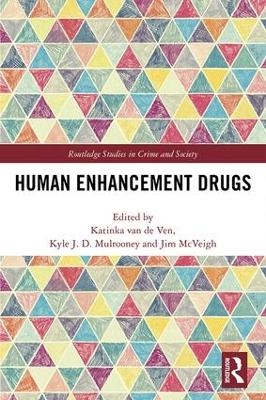
Human Enhancement Drugs
Routledge (Verlag)
978-1-138-55279-1 (ISBN)
Despite increasing interest in the use of human enhancement drugs (HEDs), our understanding of this phenomenon and the regulatory framework used to address it has lagged behind. Encompassing public health, epidemiology, neuroethics, sport science, criminology, and sociology, this book brings together a broad spectrum of scholarly insights and research expertise from leading authorities to examine key international issues in the field of HEDs. As "traditional" and other "new" drug markets have occupied much of the academic attention, there has been a lack of scholarly focus on human enhancement drugs. This book provides readers with a much-needed understanding of the illicit drug market of HEDs. The authors, from a variety of cultural contexts, disciplines and perspectives, include both academics and practitioners. Topics explored in this collection amongst others include:
• The anti-doping industry and performance and image enhancing drugs
• Steroids and gender
• The use of cognitive enhancing drugs in academia
• The use of sunless synthetic tanning products
• The (online) trade of HEDs
• Regulations of the enhancement drugs market
This collection will serve as a reference for students, academics, practitioners, law enforcement and others working in this area to reflect on the current state of research and consider future priorities. This detailed exploration will provide a valuable knowledge base for those interested in human enhancement drugs, while also promoting critical discussion.
Katinka van de Ven is a Research Fellow as part of the Drug Policy Modelling Program (DPMP) at the Social Policy Research Centre (SPRC), University of New South Wales. Katinka’s research focuses on the use and supply of performance and image enhancing drugs (PIEDs), which includes projects surrounding the prevention of PIED use, harm reduction policies and improving healthcare services for users. She is Honorary Research Fellow at the Public Health Institute, Liverpool John Moores University. Katinka is Editor-in-Chief of Performance Enhancement & Health and the Director of the Human Enhancement Drug Network (HEDN) (www.humanenhancementdrugs.com). Kyle J. D. Mulrooney is a lecturer in Criminology at the University of New England and the co-director of the Centre for Rural Criminology (UNE). His primary field of research is the Sociology of punishment in which he has examined issues ranging from the nexus between penal populism and political culture to the areas of drug policy and rural crime. He is also particularly interested in the use, supply, and regulation of enhancement drugs. Kyle holds a PhD in Cultural and Global Criminology from the University of Kent and Universität Hamburg, an MA in the Sociology of Law from the International Institute for the Sociology of Law and a BA (Honours) in Criminology and Justice from the University of Ontario Institute of Technology. Jim McVeigh is the Director of the Public Health Institute at Liverpool John Moores University. He has worked within health/public health for over 30 years and has built an international reputation within the field of human enhancement drug use, in particular, the use of anabolic steroids and associated drugs within the general population.
1. An introduction to human enhancement drugs Part I: Understanding the use of human enhancement drugs in society 2. More than unnatural masculinity: gendered and queer perspectives on human enhancement drugs 3. The anti-doping industry coming of age: in search of new markets 4. The social construction of human enhancement: implications for sports 5. Steroid madness: has the dark side of anabolic-androgenic steroids (AAS) been over-stated? 6. Licit forms of performance enhancement and possible links with IPED use: current knowledge and future directions Part II: Human enhancement drugs, harms and public health 7. Infections and risk among people who use image and performance enhancing drugs 8. "Objects in the mirror are larger than they appear": steroids and body image disorders 9. Estimated prevalence, effects and potential risks of substances used for cognitive enhancement 10. "Beauty through the eye of a needle": an online study of the practices and beliefs of people who inject performance and image enhancing drugs (PIEDs) 11. The use of sunless synthetic tanning products 12. The non-medical uses of prescription stimulants in the Australian context Part III: Illicit human enhancement drug markets and their suppliers 13. The (online) supply of illicit lifestyle medicines: a criminological study 14. A preliminary attempt to scope the market for doping products in Italy 15. Trust, risk and deceit in the illicit medicines market: an analysis of the on- and offline trust relations between sellers and buyers of illicit medicines 16. The open bar has closed: changes in the patterns of doping supply in elite cycling 17. The supply of Image and Performance Enhancing Drugs (IPED) to local non-elite users in England: resilient traditional and newly emergent methods Part IV: Responding to human enhancement drugs 18. Different users, different interventions: on the ideal typology of anabolic-androgenic steroid use and its implications for prevention, harm reduction and treatment 19. The war on anabolic-androgenic steroids: an examination of U.S. legislative and enforcement efforts 20. Preventing image and performance enhancement drug use: it's not all chalk and talk 21. How to respond to the increasing use of cognitive enhancers in academia? 22. One size does not fit all: tackling the issue of weight-loss drug use
| Erscheinungsdatum | 24.06.2019 |
|---|---|
| Reihe/Serie | Routledge Studies in Crime and Society |
| Zusatzinfo | 9 Tables, black and white |
| Verlagsort | London |
| Sprache | englisch |
| Maße | 156 x 234 mm |
| Gewicht | 453 g |
| Themenwelt | Sachbuch/Ratgeber ► Gesundheit / Leben / Psychologie |
| Recht / Steuern ► Strafrecht ► Kriminologie | |
| ISBN-10 | 1-138-55279-8 / 1138552798 |
| ISBN-13 | 978-1-138-55279-1 / 9781138552791 |
| Zustand | Neuware |
| Informationen gemäß Produktsicherheitsverordnung (GPSR) | |
| Haben Sie eine Frage zum Produkt? |
aus dem Bereich


